BIBLIOGRAPHY
Brewer, Ted. Ted Brewer Explains Yacht Design . Camden, ME: International Marine Publishing Company, 1985.
Coles, Adlard K. Heavy Weather Sailing , 3rd Edition. Clinton Corners, NY: John de Graff, 1981.
Gibbs, Tony. The Coastal Navigators Notebook . Camden, ME: International Marine Publishing Company, 1979.
Henderson, Richard. Sea Sense , 2nd Edition. Camden, ME: International Marine Publishing Company, 1979.
. Understanding Rigs and Rigging . Camden, ME: International Marine Publishing Company, 1985.
Maloney, Elbert S. Piloting Seamanship and Small Boat Handling , 56th Edition. New York: Hearst, 1983.
Marchaj, C. A. Sailing Theory and Practice , Revised Edition. New York: Dodd, Mead & Company, 1982.
Meisel, Tony. Undersail . New York: Macmillan, 1982.
Ross, Wallace. Sail Power , Revised Edition. New York: Knopf, 1984.
Rousmaniere, John. The Annapolis Book of Seamanship . New York: Simon and Schuster, 1983.
Schlereth, Hewitt. Commonsense Coastal Navigation . New York: W.W. Norton and Company, 1982.
Sherwood, Richard M. A Field Guide to Sailboats . Boston: Houghton Mifflin Company, 1984.
Sleightholme, Des. Better Boat Handling . Newport, RI: Seven Seas Press, 1983.
Tate, William H. A Mariners Guide to the Rules of the Road , 2nd Edition. Annapolis, MD: Naval Institute Press, 1982.
Toss, Brion. The Riggers Apprentice . Camden, ME: International Marine Publishing Company, 1984.

SAILING
THE BASICS

An imprint of Globe Pequot
Distributed by NATIONAL BOOK NETWORK
Copyright 2003, 2018 Dave Franzel
All rights reserved. No part of this book may be reproduced in any form or by any electronic or mechanical means, including information storage and retrieval systems, without written permission from the publisher, except by a reviewer who may quote passages in a review.
British Library Cataloguing in Publication Information available
Library of Congress Cataloging-in-Publication Data available
ISBN 978-1-4930-2980-8 (paperback)
ISBN 978-1-4930-2981-5 (e-book)
 The paper used in this publication meets the minimum requirements of American National Standard for Information SciencesPermanence of Paper for Printed Library Materials, ANSI/NISO Z39.48-1992.
The paper used in this publication meets the minimum requirements of American National Standard for Information SciencesPermanence of Paper for Printed Library Materials, ANSI/NISO Z39.48-1992.
Printed in the United States of America
PREFACE
Years ago a graduate of the Learn to Sail Course at the Boston Sailing Center returned from a glorious sail one day and proclaimed for all who cared to listen: Sailing is like life, only more so!
Indeed, sailing can take you in many directionsfrom messing about in a little boat on a lake, to windsurfing, to daysailing, to local and coastal cruising, to ocean cruising, to dinghy and one-design racing, to handicap racing, to ocean racing, and more. And when you consider that within any one of these realms you will experience a wide range of wind, wave, and numerous other conditions, as well as the pleasure of understanding a bit more about sailing each time you go out, this fellow was not far off.
Whichever direction sailing may take you, however, it is generally best to start at the beginning, which brings me to the purpose of this book. As the text for the Learn to Sail course at Boston Sailing Center, this book is designed to guide a newcomer through all the information necessary to sail safely and welland it has been doing just that for thousands of new sailors for more than 30 years. Since sailing safely and well requires a thorough knowledge of the basics, my goal for this book is to develop in readers an appreciation for why things work the way they do as opposed to restating traditional litanies that pass for understanding.
For example, ask 100 sailors how a sail generates force to drive a boat against the wind and 95 of them will tell you about Bernoullis Principle and leave it at that. Notwithstanding Mr. Bernoullis excellent credentials, his principle provides little visual or intuitive explanation of what actually occurs as wind flows over sails or how that translates into moving a boat.
This book endeavors to offer points of view that may be readily visualized. In my experience teaching sailing, I have found that the more thorough ones understanding of the underlying reasons why things work, the more readily one moves on to more advanced concepts. This process, in my opinion, makes learning more fun. And the more fun one has while learning, the better one learns, and the more exciting it becomes to learn more. And so on.
This book was written with the importance of thorough understanding as a guiding principle. Therefore, where possible, new concepts are derived from or follow from previously discussed information. One purpose in presenting information in this manner is to make it easier to read and to avoid the problem many sailing texts have of presenting new information without connecting it to what has gone before. Another purpose is that this developmental approach corresponds to one of the ways by which I hope readers will continue to refine their knowledge of sailing after they finish the book.
A few beginners have told me that they feel the sections on balance and sail shape are unnecessarily taxing for individuals not interested in racing. I could not disagree with this more. Sailing with your boat balanced, heeling no more than necessary, and above all maintaining control at all times are every bit as important to cruising or daysailing as they are to racing. A knowledge of proper sail-shape control is essential to sailing safely under a wide range of wind and wave conditions regardless of the type of boat you sail. On the other hand, there is a lot of new information in those sections, and I recommend that you not expect to digest it all in one reading, but rather read it and then refer to it as you continue sailing until the information becomes clear.
This book is intended as a thorough presentation of the basics. It is not intended to be the last word on any subject contained herein. Ive included a bibliography for further information on specific subjects. On the other hand, no book or individual has all the answers. Experienced sailors continue to learn more every time they sail. The more experience you gain, the finer the points you learn. Thats the beauty of sailing. Enjoy!
Types of Sailboats
There is a wide variety of boats you can sail; each type of boat creates its own sailing experience. A view of the different categories of modern sailboats will help you see what you are getting into.
CENTERBOARD OR KEEL?
One of the main attributes that differentiates a sailboat from other craft is the underwater blade that helps keep a sailboat going straight and prevents it from slipping sideways, even against a powerful sideways wind. There are two types of blades that serve this purpose: keels and centerboards.
A keel is a fixed structure securely attached to the underside of the hull. It invariably weighs a lot (typically 40 to 60 percent of the boats total weight), which makes a keelboat very stable (Figure 1.1).
A centerboard, on the other hand, is a blade that can pivot from a straight down position up to a fully retracted position inside the boat. This is desirable when there is no sideways wind or when you want to land on a beach.
While centerboard boats enjoy several advantages over keelboats (price, speed, and sensitivity, for example), they do capsize more easily. However, while accidental capsizing can be extremely unpleasant and in some cases dangerous, many of the modern, relatively small centerboard boats designed with large, watertight flotation tanks (the Laser, 420, 470, Flying Scot, Lark, and Sunfish, to name but a few) are relatively easy to right again and generally come up dry and ready to sail (Figure 1.2). You can usually right a centerboard boat by standing on the centerboard (Figure 1.3).


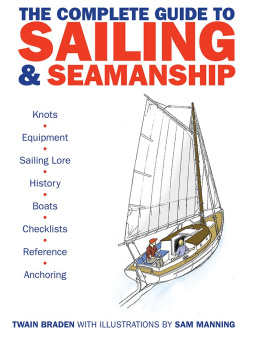

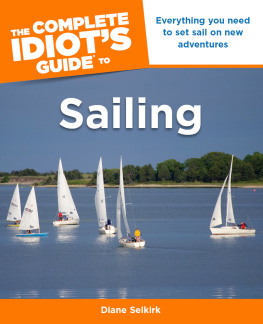
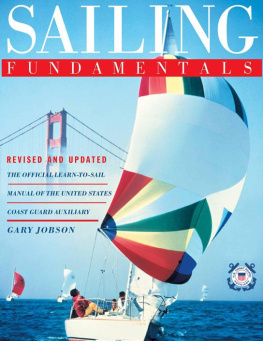
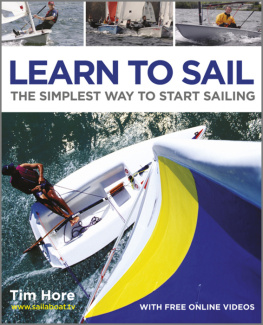
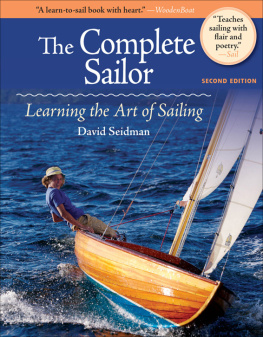


 The paper used in this publication meets the minimum requirements of American National Standard for Information SciencesPermanence of Paper for Printed Library Materials, ANSI/NISO Z39.48-1992.
The paper used in this publication meets the minimum requirements of American National Standard for Information SciencesPermanence of Paper for Printed Library Materials, ANSI/NISO Z39.48-1992.